For internet movie geeks, a plot hole is the gravest of sins. Solid acting and great special effects can be forgotten in an instant if the writers or director accidently leaves a major hole in the story. While fans will gladly suspend their belief, in reality, a little bit to watch an epic sci-fi, fantasy, or action film, plot continuity is still an incredibly important aspect of filmmaking. One wrong step can completely ruin the immersive viewing experience.
Over the years, there have been plenty of blockbuster movies called out for having plot holes, both big and small. In many cases, those complaints are valid. Sometimes, however, it’s more a matter of know-it-all fans trying too hard to nitpick at someone else’s favorite movie.
In this article, we’re going to look at 12 commonly cited plot holes in some of our favorite movies. Only instead of complaining about the stupid writers or director who made the blunder, we’re going to tell you why these moments aren’t really plotted holes at all. If you look a little deeper, they all make perfect sense.
12. How Did They Upload That Virus in Independence Day?
Everyone thinks Will Smith, epic fighter pilot, saved the world from aliens in Independence Day. Let’s be honest, though — it was Jeff Goldblum, elite computer hacker, who really won the battle. It was his computer virus that crippled the alien’s shield technology, finally allowing for crazy ol’ Randy Quaid to get his revenge and blow up one of the massive UFOs, turning the tide on the global battle.
A lot of people thought it was a completely bogus plot hole that a mid-90s Apple Powerbook would somehow be compatible with the advanced technology of the alien mothership. But if you listened closely in the first third of the film, you’ll remember that scientists at Area 51 explained to Smith that almost all modern technology was developed thanks to UFO that crashed at Roswell. In the ID4 universe, that specific event is fact, not a conspiracy theory. There’s even a deleted scene where Goldblum’s character makes a comment about the alien software having similar coding to his laptop, which it totally explainable given where the laptop technology came from.
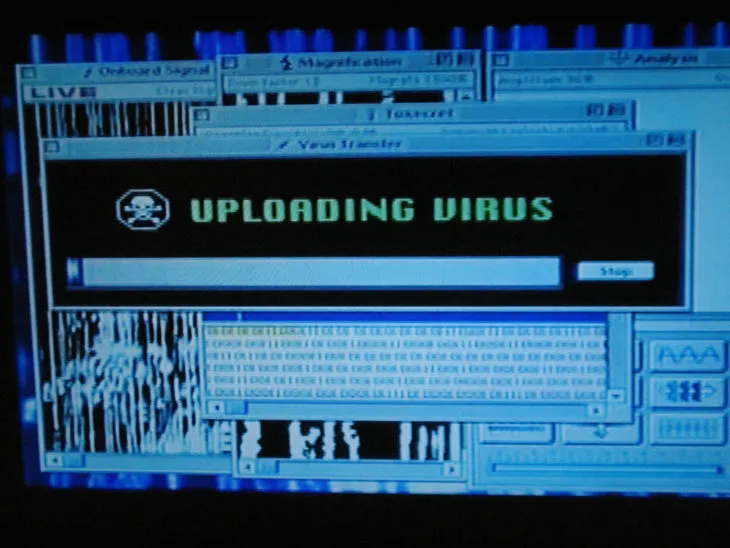 Source: Screenshot via 20th Century Fox
Source: Screenshot via 20th Century Fox 11. Why Didn’t They Keep Using The Time Turner in Harry Potter 3?
In the third Harry Potter movie, Hermoine finds herself making the use of a Time-Turner, a magical device that lets wizards and witches travel back in time. Naturally, she only used it to take an extra-heavy course load and cram in extra studying time. When Harry finds out about it, they use it to save Buckbead the hippogriff from execution and free Sirius Black. But why didn’t they ever consider using it for something really useful? Like going back in time and saving Harry’s parents or killing Voldemort as an infant?
Time travel in movies is always a tricky subject, and paradoxes are inevitably created. In this case, Harry Potter is not like Back to the Future. Changing something in the past does not alter the future. Instead, time is more linear. The Time-Turner only allows things to happen in the past that has already happened, which is why Harry and Hermoine were waiting for the distraction that saved Buckbeak before realizing that they were the distraction. And also why Harry was waiting for his father to come to save his future self from the Dementors before realizing he needed to do it himself.
Hermoine also warned that “bad things happen to wizards who meddle with time,” meaning that she was probably smart and responsible enough to never overuse the Time-Turner. Perhaps she even destroyed it or locked it away after the events of Prisoner of Azkaban so that it wouldn’t be abused.
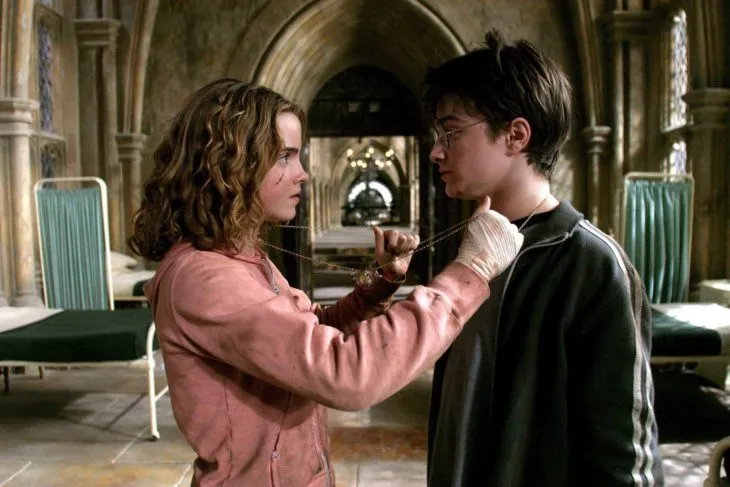 Source: Screenshot via Warner Bros.
Source: Screenshot via Warner Bros.10. Why Did Scar Let Simba Live in The Lion King?
We know from basically the start of The Lion King that Scar is a murderous villain. After taking out Mufasa, he inexplicably refuses to kill the younger Simba, aka the actual heir to the throne and the only living creature that could challenge his rule as leader of the Pride Lands. For a cold, calculated, and ruthless monster like Scar, not killing Simba seems like a pretty big misstep, right?
Wrong.
He did try to kill him — twice! He fully expected Simba to die in the stampede with his father. And let’s be honest, that almost worked if not for the heroism of Mufasa saving his son. When that didn’t decimate the royal family, Scar scrambled for a backup plan. He sent his bumbling hyenas to finish the job (maybe to ensure he doesn’t get blamed himself), but they incompetently allow the young cub to escape. Sure, maybe Scar should have taken care of the job himself, but he definitely didn’t just “forget” to kill Simba.
 Source: Screenshot via Disney
Source: Screenshot via Disney9. Why Not Shoot The Escape Pod in Star Wars?
The entire Star Wars saga could have been avoided if those two Imperial officers weren’t so stingy on shooting space junk out of the sky. After Princess Leia hides the plans for the Death Star in R2-D2, the lovable droid escapes the clutches of Darth Vadar by jettisoning out to Tatooine in an escape pod with C-3PO. A couple of guards see the escape pod floating through space, but choose not to destroy it because scans reveal there are no life forms onboard. But these guards also live in a universe where intelligent androids exist and can, ya know, store data!
At first glance, it may seem like a glaring plot hole but bear with me for a minute. First of all, when R2-D2 first tried to get into the escape pod, C-3PO clearly says he’s not permitted to be in there. That suggests there is some kind of galactic protocol that escapes pods are for living things only, which is why the guards would never fathom a droid using one. Another point is that the Empire didn’t want the Death Star plans destroyed, they simply wanted them back. Maybe they planned to build more? Either way, recklessly shooting at unknown (and almost certainly empty) escape pods would have been a bad decision for these guys. And when your boss is a Sith Lord who can force choke you to death, it’s best to avoid making bad decisions.
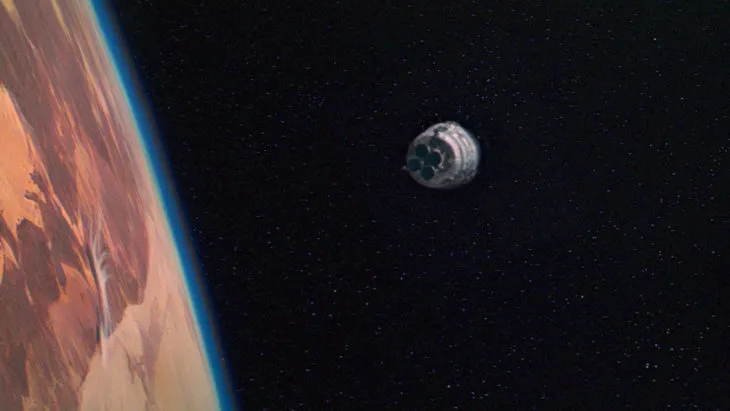 Source: Screenshot via 20th Century Fox
Source: Screenshot via 20th Century Fox 8. Wouldn’t The Microwave Emitter Kill Everyone in Batman Begins?
Christopher Nolan’s Dark Knight trilogy of Batman movies are among some of the best superhero movies ever made, especially the much-loved middle film featuring Heath Ledger as the Joker. While they are expertly acted and brilliantly shot, the movies aren’t without their own logic breaking situations. For example, how do all of Joker’s plans, which require other people to act in very specific ways, always seem to work? Is he a master of human psychology or just really lucky? Furthermore, how does Bruce Wayne get back into Gotham after it was locked down in The Dark Knight Rises? The answer is supposed to be “because he’s Batman, duh,” but that’s a little short on details.
In Batman Begins, the villain Ra’s Al Ghul is attempting to destroy Gotham by poisoning the water supply with a psychoactive hallucinogenic drug that will turn all the citizens into murderous lunatics. It’s only active when inhaled as a power, though, so he steals a military weapon called a microwave emitter that will quickly zap all the water into non-existence. The plot hole is that humans are, like, 75 percent water and the population would certainly die when it’s turned on.
Except they already covered that. When discussing the weapon’s capabilities, we heard that the device can be specifically targeted. As in, it’s directional. Ra’s Al Ghul was planning to aim it down towards the sewers and water pipes, not up into the high rise apartment buildings. It’s possible that a few unlucky people would have been vaporized in the process, but for the most part, the microwave emitter would have worked exactly as planned.
 Source: Screenshot via Warner Bros.
Source: Screenshot via Warner Bros. 7. How Did Bruce Banner Suddenly Control His Hulk Powers in The Avengers?
The whole point of The Hulk is that he’s a bit unpredictable. Sure, he’s a superhero with extremely powerful strength and is basically immortal in Hulk form, but he’s not supposed to be able to control his transformation. His tag line is even “don’t make me angry — you won’t like me when I’m angry.”
In The Avengers, they spend a lot of time talking about making sure Dr. Bruce Banner doesn’t get upset or needlessly stressed, in case the “other guy” makes an unwelcome appearance. But then at the end of the movie, when he’s needed most, Banner simply declares “that’s my secret. I’m always angry,” and transforms into the Hulk at will. So what gives? Can he control his powers or not?
It’s hard to remember now, but The Incredible Hulk movie starring Edward Norton is also considered to be canon in the Marvel Cinematic Universe, even though Norton was later replaced by Mark Ruffalo as Banner/Hulk. At the end of that movie, we see Banner learning to control his rage and transforming on purpose. So the answer was right out in the open, the whole time. He does still hulk out randomly when under the influence of mind-altering powers though, as seen by his transformation while under the spell of Loki’s staff or Scarlett Witch’s powers.
 Source: Screenshot via Marvel Studios
Source: Screenshot via Marvel Studios 6. Why Didn’t Jack and Rose Share the Door in Titanic?
Even though everyone knew the boat was going to sink at the end, James Cameron’s epic historical drama about the sinking of the Titantic made a killing at the box office and became a critical darling for the sheer accomplishment of it all. It was a really difficult movie to shoot, and Cameron (and his cast and crew) produced some truly stunning visuals. But fans of the love story between Jack (Leonardo DiCaprio) and Rose (Kate Winslet) were annoyed at what they thought was a glaring plot hole at the end, when Rose was able to escape the frigid waters of the Atlantic Ocean by floating on a piece of wooden door, while Jack slowly froze to death clinging to the side of it.
“There was room for both of them,” you’ll near critics shout.
Sorry, but that’s not how science works. It’s a simple matter of buoyancy. The door only has so much capacity to float, and adding the 180-pounds of another adult male to equation would have caused it to sink. In fact, they tried. Go watch the movie again, and you’ll notice that both Jack and Rose attempt to get on the door together, only to have to flip over due to the weight. Jack may not be a genius, but he quickly realizes that only one of them will be able to survive on the door.
 Source: Screenshot via Pictures
Source: Screenshot via Pictures5. Who Heard Kane Say “Rosebud” in Citizen Kane?
Even though it was released way back in 1941, Citizen Kane is still considered one of the greatest movies of all-time. If you haven’t seen it, it revolves entirely around a reporter trying to get to the bottom of the mysterious last words of famous publishing millionaire Charles Foster Kane. The movie opens with Kane (Orson Welles) uttering the word “Rosebud” with his dying breath, but there’s a problem: no one was around to even hear him say it. The scene shows Kane alone in his bedroom, and a maid comes in shortly after to discover he has passed away.
At first, this seems like a major problem. How can you make a movie about something that no one actually knows happened? Who even heard his last word? If you’re paying close attention later in the film, though, you’ll notice that they actually closed this loophole pretty neatly. When the reporter is interviewing Kane’s butler, he mentions that he was with Kane when he died. So just because he didn’t appear in the opening scene, doesn’t mean he wasn’t standing in a corner, off-camera. So who heard Kane say “rosebud?”
The Butler did it.
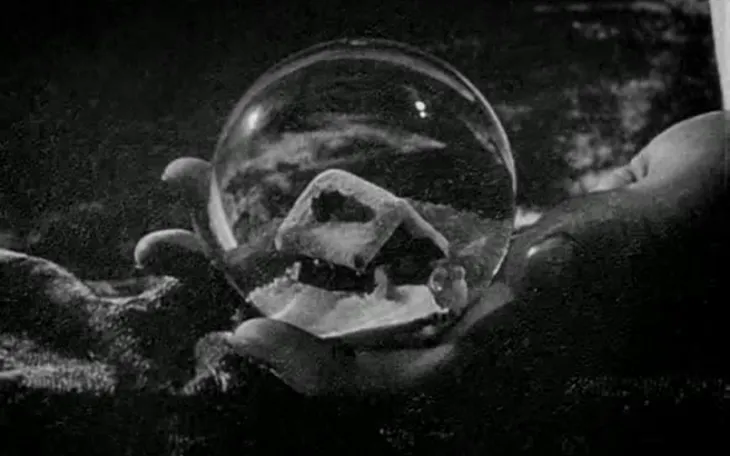 Source: Screenshot via RKO Radio Pictures
Source: Screenshot via RKO Radio Pictures 4. Why Didn’t Malcolm Realize He Was a Ghost in The Sixth Sense?
Long before movie audiences knew to expect a twist ending from director M. Night. Shyamalan, The Sixth Sense came along in 1999 and blew people away. Bruce Willis was dead the whole damn time!?! No one saw it coming on their first watch through, but as the movie aged and fans took the time to re-watch it again and again, a glaring plot hole cropped up — how could Malcolm Crowe (Willis) not realize he was already dead?
The movie takes place over a number of weeks and months. Wouldn’t Malcolm realize that the only person who acknowledges his presence is his young friend Cole? He can’t even get a response from his own wife.
The movie plays tricks on the audience, making it seem like Malcolm is just being neglected. But the truth is there the whole time. In an early discussion about his ability to “see dead people,” Cole reveals that ghosts will subconsciously ignore the reality of their situations and instead see an alternate version of reality that convinces them they are still alive. That’s the reality that Malcolm sees, and also the reality that is shown to the audience at times, from his unique perspective.
Simply put: ghosts, by their very nature, don’t believe they are dead. They will twist the facts in their own mind to convince themselves of this, which is why it takes Malcolm so long.
 Source: Screenshot via Buena Vista Pictures
Source: Screenshot via Buena Vista Pictures 3. How Did Andy Put The Poster Back on His Wall in The Shawshank Redemption?
In The Shawshank Redemption, Andy Dufresne simply disappears from his cell in the middle of the night, much to the confusion of the guards and Warden Norton. As they angrily try to figure out how he escaped, the great plot twist is slowly revealed. He crawled out through a hole in the wall, chiseled over decades of prison time with a small rock hammer, that was concealed by a poster of the latest pinup model. It started with Rita Hayworth and finished with Raquel Welch. But some viewers were quickly calling BS on the dramatic reveal, claiming that Andy wouldn’t have been able to re-secure the poster to the wall to hide his escape route.
This is a pretty thin complaint if you ask me. It’s pretty obvious that the poster is only attached by the top two corners and simply hangs down over the escape hole due to gravity. Andy just lifted up the bottom of the poster, crawled through, and let the laws of physics take care of putting the poster back into place.
For people who say its unrealistic for Andy to bother putting the poster back at all (after all, once he’s gone it doesn’t matter), I say this: when you’re escaping from prison, every additional second that passes before the guards realize you’re gone is extremely valuable. Maybe a guard would have noticed the hole in the middle of the night while making rounds but didn’t look closely enough to realize that Andy wasn’t in his bed. Putting the poster back could have been the difference between getting caught and Andy’s new freedom.
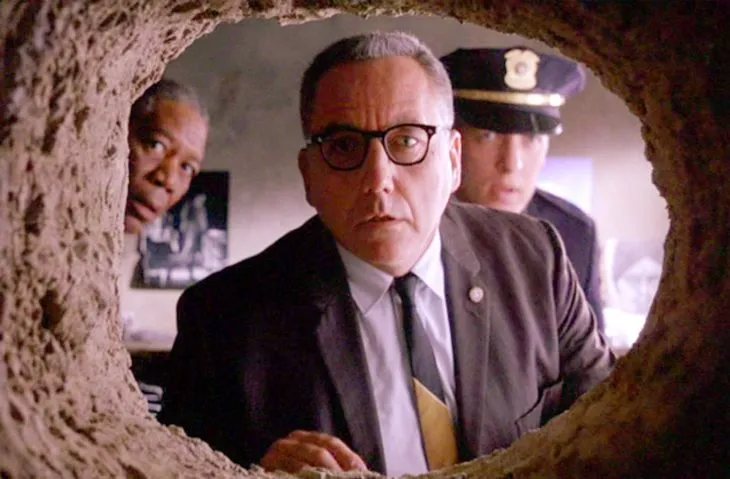 Source: Screenshot via Columbia Pictures
Source: Screenshot via Columbia Pictures 2. If Buzz Doesn’t Think He’s a Toy, Why Does He Freeze Like One?
In Pixar’s Toy Story, Buzz Lightyear is a fancy new space ranger action figure who insists vehemently that he not, in fact, a toy. He believes his laser weapon is real and that he’s been to outer space to battle the evil alien Emperor Zurg. It takes almost the full movie for Woody to convince Buzz that he’s actually just a mass-produced piece of plastic to be loved (and eventually discarded) by children.
But if Buzz is certain that he’s not really a toy, why does he freeze whenever Andy (or any other human) comes around? Seems like a big plot hole, right? There are two potential answers, both along the same line of thinking. The first is that Buzz is using his training as an elite Space Ranger to play dead in the presence of unknown giant creatures, and it’s just a coincidence that the other toys also freeze. The second is that Buzz is in a strange environment, and is merely mimicking the locals as a survival tactic until he can get a better understanding of what is going on. Either way, it’s not because he doesn’t believe his own story.
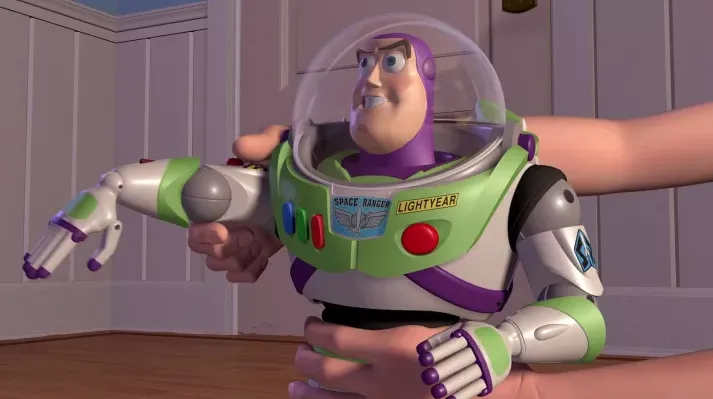 Source: Screenshot via Disney/Pixar
Source: Screenshot via Disney/Pixar1. How Are There Explosions on Pandora in Avatar?
In James Cameron’s epic 3D fantasy-adventure flick Avatar, all the action takes place on the planet Pandora, where humans are mining a valuable energy source out from underneath the native species, the Na’vi. The rest of the plot isn’t really important, although it’s basically a combination of Pocahontas and Fern Gully: The Last Rainforest, but with better special effects. What is important is that as the humans wreak havoc on Pandora, we see multiple explosions and things being set on fire. But we were told early in the movie that humans cannot breathe on Pandora, so how can there be combustion, which literally requires oxygen?
The answer is simpler than you think. The movie doesn’t actually say that the Pandora atmosphere is devoid of oxygen. Rather it’s an over abundance of poisonous (to humans) carbon dioxide that makes humans unable to survive. There’s still oxygen in the air, it’s just vastly outnumbered by it’s deadly counterpart. Plus you can’t have cool action scenes without a few explosions.
 Source: Screenshot via 20th Century Fox
Source: Screenshot via 20th Century Fox